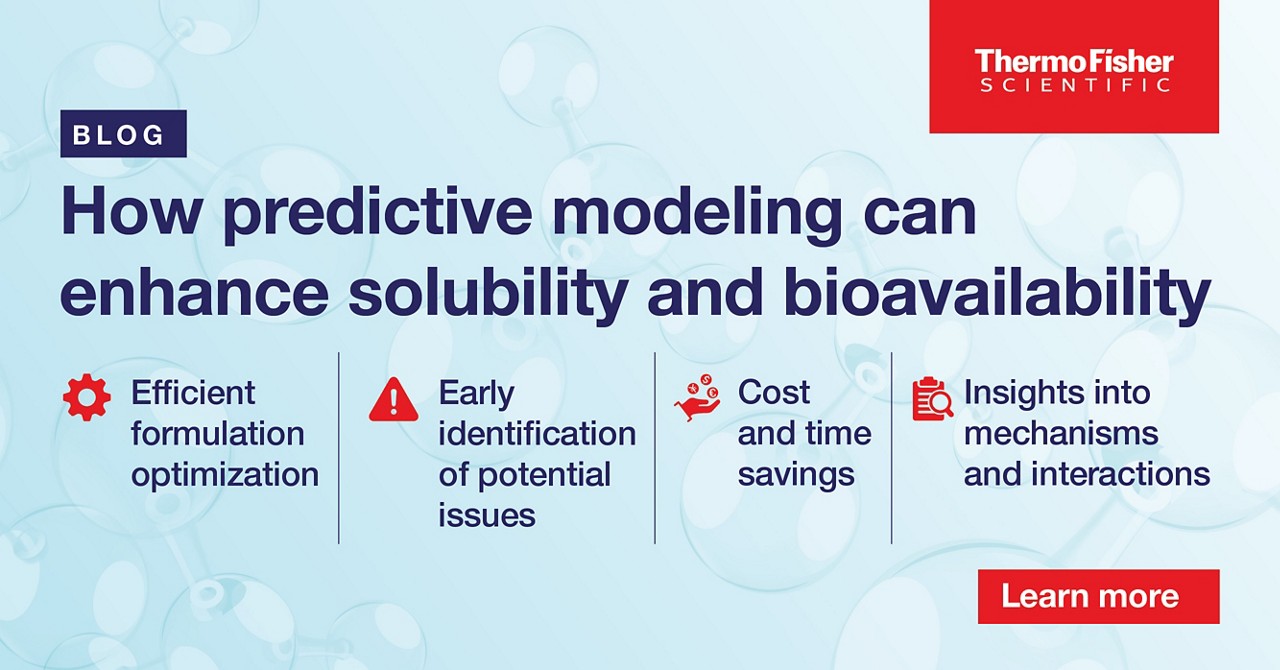Predictive modeling for solubility and bioavailability enhancement
Category | Small molecule
In the field of pharmaceutical formulation, overcoming the challenges of poor solubility and low bioavailability are critical steps in transforming promising compounds into viable therapeutics. It’s estimated that between 70% and 90% of new chemical entities (NCEs) in the drug development pipeline are poorly soluble, which can lead to bioavailability issues. Therefore, solubility plays a crucial role in the bioavailability of a drug, since poor solubility can limit absorption, leading to inadequate therapeutic levels in the bloodstream.
To help overcome these challenges and develop game-changing therapies for patients, drug developers are increasingly turning to advanced technologies and techniques such as predictive modeling via computational simulation — or in silico modeling — to streamline the drug development process and aid in early pharmaceutical formulation efforts. Before diving into the potential of predictive modeling for solubility and bioavailability enhancement, let’s explore the respective roles of solubility and bioavailability in more detail.
What is solubility?
Solubility refers to the ability of a drug to dissolve in a particular solvent, usually water or other physiological fluids, to form a homogenous solution. Solubility is a critical factor in the pharmaceutical industry, influencing the absorption, distribution, and bioavailability of a drug within the human body.
What is bioavailability?
Bioavailability refers to the fraction of a drug that reaches the body’s circulatory system unchanged after administration and is therefore able to produce a therapeutic effect. Bioavailability is directly influenced by a drug’s solubility, its stability in the digestive system, and its ability to cross biological barriers.
Exploring the challenges of poor solubility and low bioavailability
Poor drug solubility and low bioavailability are critical challenges that today’s pharmaceutical formulators face, impacting the safety and efficacy of investigational products (IPs). Several factors contribute to these challenges and addressing each of them comes with its own set of considerations. Below are some of the most common challenges associated with poor solubility and low bioavailability:
- Formulation complexity: Addressing poor solubility and low bioavailability often requires overly complex formulations that require specific excipients, nanotechnology manipulation, and advanced delivery systems. As a result, manufacturing processes will be more complicated.
- Increased costs and timelines: Overcoming solubility and bioavailability challenges may necessitate extensive research, development, and testing, leading to increased costs. The need for specialized technologies and additional studies can also extend project timelines.
- Patient convenience and compliance: Non-optimized drug formulations may require frequent dosing schedules or inconvenient administration methods, which can negatively impact patient compliance to prescribing protocols. Moreover, higher drug doses can increase side effects.
- Regulatory hurdles: Poor solubility and low bioavailability may influence regulatory approval by necessitating rigorous assessment, documentation, and potentially additional studies to ensure compliance with standards for bioequivalence, stability, safety, and quality control.

The impact of formulation strategies on solubility and bioavailability must be considered from the early stages of formulation development to avoid costly errors during later stages of development. Historically, researchers have used a trial-and-error approach to select technologies and formulations for enhancing solubility and bioavailability. However, innovative predictive modeling via computational simulation — or in silico modeling — that simulates API-polymer interactions replaces empirical, trial-and-error approaches with a more rational, efficient strategy.
How can predictive modeling enhance solubility and bioavailability?
Predictive modeling in pharmaceutical research employs mathematical algorithms and computational simulations to predict outcomes to various scenarios. This advanced methodology utilizes innovative technology including artificial intelligence (AI) and machine learning to model complex biological, chemical, and physical processes, providing data-driven insights into the behavior of drugs, their interactions with biological systems, and to inform formulation strategies. In the context of solubility and bioavailability enhancement, predictive modeling offers several advantages, including:
- Efficient formulation optimization: Predictive modeling allows researchers to explore and optimize various formulation parameters, such as excipient selection and processing conditions. By simulating the impact of different variables, scientists can identify formulations that are likely to improve solubility and bioavailability, reducing the need for trial-and-error experiments.
- Early identification of potential issues: Predictive models enable the early identification of potential issues related to solubility and bioavailability. By assessing the impact of various factors, such as excipient choice or particle size, scientists can select the most promising options for further experimental validation to avoid potential roadblocks in later stages.
- Cost and time savings: By strategically planning and optimizing formulations through predictive modeling, scientists can reduce the consumption of resources associated with materials, equipment, and time. Instead, they can focus their efforts on formulations with a higher probability of success, while accelerating overall project development timelines.
- Insights into mechanisms and interactions: Predictive models provide insight into the underlying molecular interactions and mechanisms governing solubility and bioavailability. Understanding these factors helps researchers make informed decisions about formulation components and predict how changes in the molecular structure may influence bioavailability.
The future of predictive modeling in drug research and development
Proactively addressing solubility and bioavailability issues is one of the top priorities of today’s drug developers, as a drug’s overall efficacy depends on its ability to dissolve and be absorbed by the body. In this context, the future of predictive modeling in drug development is highly promising, particularly as advancements in computational methods, AI, machine learning, and data analytics arise.
Addressing the complex challenges of solubility and bioavailability in drug development calls for innovative solutions. For example, Thermo Fisher Scientific’s Quadrant 2TM predictive platform uses a range of computational methods to analyze a drug compound’s unique molecular structure and chemical characteristics to accurately identify optimal bioavailability and solubility enhancement techniques and excipient combinations.
With the ability to analyze vast datasets and predict complex interactions between drugs and biological systems, innovative tools like Quadrant 2TM that enable predictive modeling via computational simulation streamline decision-making in early-stage development projects. Therefore, they can reduce experimental trial-and-error costs and even accelerate the identification of novel drug candidates.
As our understanding of molecular biology and personalized pharmacology deepens, predictive models are expected to become increasingly advanced, allowing for more accurate simulations of overall drug behavior. This evolution is paving the way toward a new era in drug development, where the focus extends beyond fundamental formulation challenges such as solubility and bioavailability to encompass the development of more effective and personalized medications.
To learn more about the power of predictive modeling via computational simulation, download our recent whitepaper: "Advancing drug development using in silico modeling".


